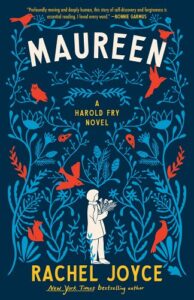What It’s Like To Write About the Same Characters For Over a Decade
Rachel Joyce on Worldbuilding Across a Trilogy and Finally Letting Go
Last week I found myself not at my desk, but in a rehearsal room. I had a script and a pencil, and I was completely open-mouthed. Because I was watching seven actors and four musicians bring to life a story that has been with me for over fifteen years. I was at a workshop rehearsal for the musical of The Unlikely Pilgrimage of Harold Fry, and all I can say is that it was like watching the inside of my head grow shoots and leaves and suddenly burst into many-colored flowers. The story had regenerated itself without me. It is no wonder I was in awe.
The musical rehearsal is the latest in a succession of “other lives” for a one-off book I wrote over ten years ago, that was actually based on a radio play I had written five years before that. The Unlikely Pilgrimage of Harold Fry is the story of an ordinary man who receives a letter out of the blue from his dying friend and makes an instinctive promise to walk the length of England in order to save her. It was my first novel and its success was not something I had ever anticipated.
Following that, came a second book, The Love Song of Miss Queenie Hennessy—the whole tale told, as it were, as a reverse shot, from the point of view of the woman for whom Harold is walking. And finally this year, there is Maureen, the story of the wife Harold left at home the day he set off on his walk. Maureen has always been the underdog—the blunt woman with a sharp tongue who would rather stay at home, cleaning, than go out and meet a stranger.
But now she too makes a journey into the unknown and finds a way, through confronting what she does not want to see, to heal a wound that has been like a splinter inside her. There is also the film of The Unlikely Pilgrimage of Harold Fry, starring Jim Broadbent and Penelope Wilton, for which I wrote the screenplay, and which will be coming to cinemas in the UK on April 28th.
So that is a lot of Harold Fry in my life.
Over the years I have been asked many times where he came from, just as I have been asked about Maureen, Queenie, and the young man, David, who is at the centre of their lives. The honest truth is that I don’t know. If they came from anywhere, I guess it was my unconscious. They started in a place of truth, or a place of private need, as many stories do, and grew from there into something that was half-known, and half-imagined.
When I first met them, my own father was dying from cancer: Harold’s story was my way of dealing with my lacerating grief—of bringing shape to something that felt to have no shape at all. It makes complete sense to me now that I chose to write about a man trying to keep a person alive, when I myself was losing my father. Harold and I made our way through his journey, against the odds. I listened to him, and to his days of wonder and days of doubt, and found a reflection of what I was feeling.
In fact Harold became so real to me, and to my family, that there were times we would drive past an elderly man on a road and my children would actually wind down their car windows and wave. A few years later, I even saw him (or at least the image of Harold Fry that was on the Thai cover) as the logo on a van advertising a stair lift company. I came home and said to my husband, “You’ll never believe this, but Harold has his own private enterprise now.”
It was a reader who first pointed out that this was a story that was going to stay with me for a while. I was doing an event, shortly after the book was published, and a woman in the signing queue said, “You do know that this is a trilogy?” My heart sort of dropped because I was still feeling lucky that I’d got to the end of the first book, and couldn’t fathom a second, let alone a third.
But I came away and knew she was right—it was as if she had opened a door to something that was already there. I began to write Queenie’s book a few years later. The more I stayed with these characters, and listened, and wrote accurately without in any way holding them back, the more I saw. I learnt too through Queenie about hospices and dying; subjects we had completely avoided with my father. My reader was right. This was a trilogy.
Except that more years passed, and I could not find Maureen. I gave up on the attempts I made, disillusioned, feeling suddenly at a distance from the characters about whom I had once believed I knew everything. Then two things happened, the first being the pandemic. We all experienced what Maureen experiences when Harold begins his walk to Queenie: that sense of existing within the same four walls, where memory and the past repeat on a loop. I thought a lot about Maureen during that time, and how grief can in itself become a safe place, a kind of identity. Though I still couldn’t see what to do with that.
The second thing that happened was the filming of The Unlikely Pilgrimage of Harold Fry. Suddenly these people that had lived inside my head, were completely outside it. They were wearing Harold’s shoes and Maureen’s head scarf and they were drinking coffee and posting letters. But did that bring me closer to Maureen? No, it seemed to accentuate the gap. I began to despair of ever being able to write her book.
Then, shortly before the end of filming, I had a sense—no, an imperative—to go to Berwick upon Tweed. I was just like Harold! I had to go. And I did, I raced up there (though I took the more conventional route and went by train.) I was able to watch the filming, to thank the crew for bringing this story to life, but all the while I was thinking, This is not the reason I am here. There is another reason. I just couldn’t see it.
The following morning I woke early and took a walk by myself along the water, going as far as I could until there was nothing ahead of me except the River Tweed and the North Sea. This may sound far-fetched but I realized in that moment the reason I had come. I was there to say thank you—to Harold, to Maureen, to whatever, for giving me those books.
I had been allowed, because of the success of those books, to hold onto my grief, and identify myself even as a daughter who had lost her father.But I was also there to say goodbye to my dad. Because, with all those years of talking about Harold Fry and recreating him, I had somehow managed not to say goodbye to my own father. I had been allowed, because of the success of those books, to hold onto my grief, and identify myself even as a daughter who had lost her father.
I don’t mean completely—because I am a wife, a mother, a sister, a daughter to my mother, and a friend. But my grieving had somehow given me a space in which it was not necessary to change, and Harold Fry was a part of that. So I said goodbye. And when I said it, I knew—as we often do when we do something that is unplanned—that this was the reason I was there. To change.
As I traveled home, if it was as if Maureen came and sat right next to me. She said, “So? What are you going to do about me? Keep running?” And I said, “No, Maureen,”—though not out loud because, of course, because I was on a train and this was an imaginary person I was conversing with. But I was finally ready to help her make that difficult journey of reconciliation that she needs to make, alone and apart from Harold, because I was ready to make that journey for myself too.
I can honestly say that every character I write stays in my bones. Harold and Maureen, Queenie and David, are a part of my life. They will always be. But I no longer need to write them, and they no longer need me. Short of becoming a board game, and trust me I have considered it, our journey is over.
If Harold discovers he has a musical voice (and I hope he does), it will be the same as me discovering a whole crowd of shadows waiting to tell their story. Writers are like therapists; we bring our characters to a place where they can live their lives more consciously. But maybe fiction can do the same for writers, if we give it time and let it run its course. Maybe it can us change too.
_________________________

Rachel Joyce’s Maureen is available now from Dial Press.




















